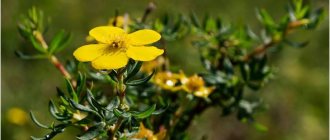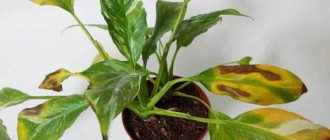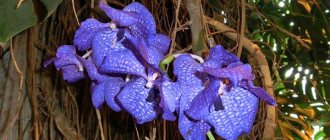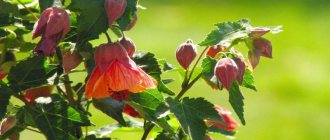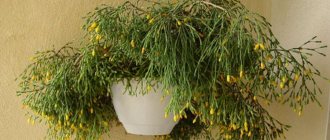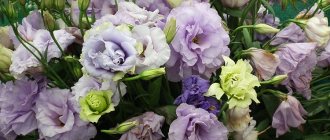Spathiphyllum: secrets of care
The home flower is popular due to its ease of cultivation and rare care procedures. The plant is not picky about the level of soil moisture and light. But still, there are certain conditions that must be met if you want “female happiness” to bloom on your windowsill.
Light and temperature
Spathiphyllum can be placed in shade or partial shade. A good option is a north window sill if the south side requires additional shading. But you need to monitor the plant; if the leaves become smaller, this is a signal of lack of lighting or drafts.
The optimal temperature for the flower is 22-23 degrees. To support a flowering plant, the indicator may be lower than 16-18 degrees.
Watering, fertilizing and proper soil
For a flower of female happiness, watering should be all year round. To prevent the roots from freezing in winter, moisture must be reduced. You can only use settled water at room temperature. When the leaves wilt, it is recommended to irrigate the flower with a spray bottle. To retain moisture, moistened sand or moss should be placed in the tray with the flower.
In addition to watering, spathiphyllum also needs fertilizing - once a week will be enough, in the spring - twice a week. You can buy a ready-made substrate for flowering plants or use universal formulations.
In the spring, the grown plant needs to be transplanted into a pot larger in size than the previous one. The substrate must consist of:
- sand (1 part),
- turf soil (2 parts),
- peat (1 part),
- leaf humus (1 part).
You can add crushed charcoal or brick to the mixture.
Reproduction
The main method of propagating a flower is by dividing the bush. In spring, the lateral shoots from the mother bush are cut off. This must be done very carefully so as not to damage the roots. The resulting parts are planted in separate containers with soil, which is used for an adult plant.
Some gardeners are trying to grow spathiphyllum from seeds. The seed material is collected, planted in peat-sandy soil, covered with a glass container or cellophane. You also need to ensure that the soil is constantly moist, but not wet. But this method has very low seed germination, so it is better to propagate spathiphyllum vegetatively.
Possible problems
The flower is unpretentious, but, like any plant, it is susceptible to pests:
- Spider mite. Only young plants are affected. For treatment, soap solution and insecticides are used.
- Shield. Culture can be ruined. If characteristic raised spots appear at the bottom of the leaves, the plant should be removed away from others and treated with tobacco crumbs or soap solution. Severely affected leaves should be cut off.
- Aphid. Activated in summer. To protect the flower, it is treated with a special solution.
- Mealybug. Settles between the leaves. You can remove one at a time using a cotton swab soaked in alcohol.
Plant diseases can be “recognized” by their appearance:
- Spathiphyllum does not bloom. The plant belongs to the araceae family, so it will not release a peduncle until the pot is completely filled with roots. You can transplant the flower into a smaller container and keep it for several weeks at a temperature of 12-15 degrees.
- The leaves are turning yellow. The leaf blade changes color if not properly cared for. Perhaps there is a lack of watering or air humidity, and pests have appeared.
- The tips of the leaves turn black and dry. The reason is the death of the roots, which is associated with excessive watering or spraying, and low temperature. Carefully remove the flower from the pot, remove the rotten parts of the roots, and replant it in new soil.
- The flowers are turning green. High room temperature or lack of nitrogen in the soil.
- The flowers turn black. This is due to improper watering, but not only with its excess, but also with its lack. Try to find a “golden mean”.
Care
Home care is not difficult. A dark, spacious room is the best location for a plant, a wonderful decoration for any home, helps purify the air, the most optimal temperature is + 20° Celsius, if the temperature is below 10 degrees, it dies. The flower reacts positively to both sun and partial shade, although it is quite heat-loving, but you should avoid direct sunlight, otherwise the leaves may turn black. If this happens, then you need to move the plant to a darker place, as much as possible. further from the window.
Spathiphyllum "Sensation".
Currently reading:
Potato variety Kolobok
Mar 4, 2022
Potato variety Kiwi
Mar 3, 2022
The health of spaphyllum depends on the season of the year; it must be protected from drafts and temperature changes. The name comes from Greek words, a flower that looks like a sword has received a symbolic name among the people: “women’s happiness”, people often notice that if a flower grows colorfully, then the house is filled with joy, happiness and harmony, and when it dries up, then in the family disagreement reigns.
An elegant tropical plant blooms from March to September, belongs to the aroid family, this variety is the largest, created specifically for landscaping dark areas. In nature, there are about forty species of spaphyllum, mainly they are distributed along rivers and seas, the stem ends in a rosette, and the tip of the leaves is elongated. The plant looks nice, but is not particularly noticeable; the color of the flower is predominantly white or yellow.
“Flower of Love” is a perennial that does not have a stem; despite the positive factors, there are also negative aspects: it can cause irritation or an allergenic reaction. At home, you can prepare decoctions for prevention and care. The following have a positive effect: raw expanded clay, potassium, phosphorus, spraying the leaves at least twice a day, you need to water so that the top ball of the earth does not have time to dry out, in winter watering is carried out once a week, also before and after using fertilizing.
A spray bottle will help maintain high humidity; the water must be boiled or well settled. In warm times, the plant needs to be fertilized four times a month, and in winter – once. The soil should be slightly sour, consist of: humus peat, turf soil with the addition of charcoal, do not forget about drainage, the nitrogen content should be low, wilted inflorescences must be removed in time. “Peace Lily” has sensitive roots, so replanting is carried out once a year (in spring), you should take a pot a little larger than the previous one, after the process, water it and put it in a warm place. Care at home should be very careful; in no case does spathiphyllum accept that when the roots are free, it stops growing.
How to grow a flower from seeds?
Spathiphyllum is rarely grown from seeds. Basically, this is done to obtain new varieties and hybrids. Seeds can be purchased at the store or obtained independently from a faded plant.
Choosing a pot
To sow seeds, take a shallow but spacious pot. Its height should not be less than 5 cm so that the soil does not dry out for a long time, and more than 10 cm so that the moisture does not stagnate. The best option would be special microgreenhouses for planting seeds, where it is easier to maintain the desired microclimate.
What should the soil be like?
It is best to purchase a ready-made substrate for aroids in the store. If it is not there, then you will have to prepare the soil yourself. To do this, mix:
- 2 parts peat;
- 2 parts sand;
- 1 part humus.
This mixture will be moderately nutritious and light. Sand can be replaced with vermiculite. If there is no humus and sand, then you can create a nutrient medium by mixing peat and a ready-made substrate for violets.
How to plant?
Planting consists of the following stages:
- Etching. If the seeds are purchased, this procedure can be omitted. Seeds are treated against fungal and bacterial diseases in preparations sold in stores: Previkur, Prestige, Maxim.
- Soak. It is done between two cotton pads or in a napkin moistened with water.
- As soon as the seeds hatch, they need to be planted. There is no need to wait for large sprouts to form. They get injured when landing.
- A small layer of drainage (fine gravel) is poured into the container to approximately a third of the height. Then the prepared mixed soil is poured.
- The soil should be shed and the seeds should be spread out in a checkerboard pattern at a distance of 2-3 cm from each other.
- Sprinkle the seeds with dry soil (1-1.5 cm).
- Place the container in a bag or cover with a transparent lid.
- As soon as the seeds germinate, the seedlings will need to be ventilated, gradually accustoming them to this - from half an hour to 3 hours.
- As soon as 3 leaves appear, small spathiphyllums can be planted in separate pots.
Of all the hatched plants, you can choose only the strongest.
Preparation for the propagation procedure (equipment, soil, container)
Before propagating spathiphyllum, prepare the necessary items and tools:
- sharpened, disinfected scissors, knife, pruning shears;
- ceramic or wooden containers;
- containers under water for temporary maintenance of cuttings;
- film or glass for organizing a mini-greenhouse.
Gloxinia - propagation by leaf and tuber at home
The land for planting should be light and fertile. You can buy ready-made soil for flower crops or prepare it yourself. In the second case you will need:
- garden soil;
- peat or humus;
- small pieces of pine bark;
- charcoal;
- a little sand.
Young seedlings need containers that are not too large, otherwise they may not bloom. Spathiphyllum does not bloom until its roots entwine the entire space of the pot.
Note! Containers must have drain holes and a drainage pad made of expanded clay or pebbles. The top of the drainage layer is sprinkled with sand.
Bloom
Spathiphyllum is loved for its unusual flowering. This is what those who are sure are waiting for: the flowering of this plant means that the house will not bypass women’s happiness. The flowers of the spathiphyllum variety “Sensation” are very large, their size reminiscent of an anthurium.
When and how?
The first flower stalks appear in the spring. A white “petal” (which is only a veil) opens, framing a real spathiphyllum flower - in the form of a yellowish cob.
This process starts in different ways. It all depends on which side the window from which the plant receives light faces. Another stimulator of flowering is temperature. It should not fall below 13-14 degrees. Flowering can occur from April to September, and a dormant period begins in the fall.
What do the fruits look like?
Spathiphyllum fruits ripen after the cob has flowered. They look like apple seeds: dark, smooth, slightly pointed on one side and curved. It is recommended to cut off the peduncle immediately after the spathe begins to fade and the cob begins to darken. Otherwise, the ripening process will deprive the flower of the forces necessary for development.
How to care for a plant at home
Any plant, even the most unpretentious one, requires attention. Care includes watering, placement, fertilizing, and pest control. In order for a “snow-white sail” to bloom on the windowsill, follow a few basic rules.
"Women's happiness" refers to shade-tolerant plants. In their homeland, they grow in the lowest layer of the tropical forest. Therefore, the plant has no special “complaints” about the lack of lighting. The flower feels great on western or eastern windows, where it is not threatened by the scorching rays of the sun. If you put a perennial in a dark place, it will not die, but it will stop blooming. And the leaves will take on a more elongated shape and become small.
What should the temperature be?
The rainforest guest grows well at room temperature, which suits it optimally.
You should not leave the flower on a cold windowsill in winter. This can lead to diseases of the root system. To prevent this from happening, you need to place a circle cut out of foam plastic or other “insulation” under the bottom of the pot. If the temperature in the room is constantly at 15˚C or lower, you may not expect flowering. You should not keep the plant in drafts, as this can lead to slower growth or death.
Optimal humidity level
Excessively dry air is harmful to large green leaves. Humidity is maintained by constantly spraying the leaves. In winter, this procedure is done three times a week. In the warm season - twice a day.
In the office, flower pots are best placed on pallets filled with wet pebbles. To maintain humidity, moistened expanded clay is also used as a filler.
Particular attention is paid to “Women’s Happiness” during the hottest summer months, when the indoor air heats up to 35˚C
How to water correctly
Spathiphyllum is a moisture-loving flower. The soil should always be slightly moist. You cannot use cold or warm water for irrigation - it must be at room temperature.
Water must be settled or collected when it rains. Too hard or chlorinated water can damage the plant. Excess liquid is drained from the pan; it should not stagnate there.
Do I need to feed
You can buy fertilizer for flowering plants at a flower shop. The application of mineral fertilizers will give regular abundant flowering.
When the “white sails” open, fertilizing needs to be done twice. At other times, when spathiphyllum is at rest - once a month. Sometimes organic fertilizers are used.
How to replant
After the plant is delivered from the store, it should be moved to another, larger pot. This is usually done two to three weeks after purchase. We must not forget to monitor the soil during this period. If the top layer dries out, watering is required.
“White Sail” perfectly accepts both the transplantation process itself and its new place. Young specimens should be replanted once a year. A mature plant is replanted only when the root system begins to fill the drainage holes. Each time a larger pot is chosen. The soil should be loose and fertile.
To obtain the optimal composition, mix
- Leaf soil;
- Sand;
- Peat;
- A small amount of black soil;
- Sod land.
The main condition for replanting is that you cannot use too “heavy” soil. This can cause moisture to accumulate in the roots. Be sure to do drainage. You can add sphagnum moss to the soil, this will prevent it from drying out often.
Description of the variety
Sensation or Sensation - spathiphyllum for office premises, institutions or large houses. It’s rare that an apartment can accommodate an adult bush. And the plant looks especially beautiful when grown not as a single rosette with splayed leaves, but as a dense clump, the diameter of which is approximately equal to the height.
Are you already growing spathiphyllum Sensation? Yes 72.34%
I'm going to buy 27.66%
What does a bush look like?
Spathiphyllum Sensation is an evergreen herbaceous plant with a short rhizome, an almost invisible stem at a young age and a rosette of oval leaves located on a thick long petiole. It grows quickly, the height of an adult bush reaches 1 m, and with good care and proper placement - up to 1.5 m.
When describing the variety in foreign sources, they indicate a maximum size of 180 cm. Flower lovers from Russia or neighboring countries have not yet reported on forums about spathiphyllum of such a height.
Sensation's plates are smooth, shiny, dark green, gracefully curved. They have the shape of an oval with a smooth edge, a pointed tip and base, reaching a length of 50 cm with a width of 30-40 cm. The central vein is thick, clearly defined, the lateral veins are deep, forming a ribbed surface.
Young lettuce leaves are erect, rolled into a vertical tube. When opened, the color gradually darkens, and with age it becomes the same as that of the other plates. They are attached to powerful thick petioles, 1-2 times longer than the size of the leaves. Proportions depend primarily on lighting.
Spathiphyllum grows quickly. The very next year after a single rosette is planted, others will appear nearby. After a few years without dividing, the bush will fill the pot and will be a colony of independent plants pressed together or fused together sideways, united by a common rhizome.
Description of the flower
The peduncles of Spathiphyllum Sensation are strong; when fully bloomed, the spathes are the same height as the leaves, or rise above them, and the stronger the older the bush. In an adult plant, the plates simply bend more, and on the periphery they are located at an acute angle to the base.
Spathiphyllum flower of the Sensation variety is:
- cream or ivory straight cob with pimples;
- a pearl-white blanket that partially encircles it, reminiscent of a sail with a strongly elongated sharp tip.
If pollination has occurred, some pimples on the cob increase in size and swell - this is where seeds have set. There is no point in leaving them - even if they successfully ripen and hatch, you will not be able to get plants that exactly reproduce the Sensation variety.
The formation of seeds or feeding of old peduncles greatly depletes the plant and prevents new buds from forming. They need to be cut off as early as possible.
With proper care, spathiphyllum blooms for a long time - from spring to autumn. Sometimes the second wave begins before or during a period of rest. But the plant still needs to rest. If the budding period occurs in autumn or winter, a long break will follow at the end of flowering.
Bloom
Spathiphyllum is loved for its unusual flowering. This is what those who are sure are waiting for: the flowering of this plant means that the house will not bypass women’s happiness. The flowers of the spathiphyllum variety “Sensation” are very large, their size reminiscent of an anthurium.
When and how?
The first flower stalks appear in the spring. A white “petal” (which is only a veil) opens, framing a real spathiphyllum flower - in the form of a yellowish cob.
This process starts in different ways. It all depends on which side the window from which the plant receives light faces. Another stimulator of flowering is temperature. It should not fall below 13-14 degrees. Flowering can occur from April to September, and a dormant period begins in the fall.
What do the fruits look like?
Spathiphyllum fruits ripen after the cob has flowered. They look like apple seeds: dark, smooth, slightly pointed on one side and curved. It is recommended to cut off the peduncle immediately after the spathe begins to fade and the cob begins to darken. Otherwise, the ripening process will deprive the flower of the forces necessary for development.
Spathiphyllum care
Temperature
. If the plant lives on the balcony in the summer, it should be brought indoors long before the onset of cold nights. Temperature conditions in winter are not lower than +16; A temperature of +10-+11 degrees is considered fatal for spathiphyllum.
Lighting
. The light is diffused. The plant needs a semi-shaded “parking lot”. It is allowed to take it out onto the balcony, but provided that it is not exposed to direct sunlight and the plant is not in a draft - spathiphyllum does not tolerate it. In the room, the flower should be in a well-lit place.
Watering
. In spring and summer - abundant, soft, lukewarm, settled water
As the weather gets colder, watering is reduced, but if the flower overwinters in a living room, moderate watering and spraying are maintained at this time. Before further watering, be sure to pay attention to the top layer of soil - it must be dry
Spathiphyllums cannot tolerate stagnant water, and high-quality drainage partly solves this problem.
Spathiphyllum loves spraying, and even a warm shower occasionally. During flowering, you need to spray the flower very carefully - make sure that water does not get on the flowers in the cob and on the blanket with which it is protected.
Top dressing
. Fertilizers are applied mineral and organic (alternately), the frequency of fertilizing is once every 7-10 days in the summer, once a month in the winter.
Earth mixture
. For spathiphyllum, the soil mixture is made up of deciduous soil, peat, humus and sand in proportions 4:2:2:1. Add broken brick and charcoal - one part of each. Good drainage is a must.
Transfer
. Annually, in the spring, in the above-described soil mixture. After transplantation, spathiphyllum is watered
Transplantation is carried out using the transshipment method. It is important not to damage the roots! The pot for replanting should be slightly larger than the previous one
A pot that is too large will force the plant to stop trying to “fill” it with roots, which will delay flowering for an indefinite period.
Reproduction
. There are three ways to propagate spathiphyllum. The most common is by dividing the bush. It is performed during transplantation. However, it is not at all necessary to remove children during transplantation.
The second option is propagation by seeds. Fruits can ripen as a result of artificial pollination. It is necessary to sow the seeds immediately after the fruit ripens, otherwise the seeds will lose their viability.
For sowing, peat and sand are mixed; The seeds are sown, the substrate is moistened, and the pot is covered with film. Leave in a warm shaded place. The pot needs to be ventilated from time to time, and the substrate needs to be watered with warm, soft water. Shoots should appear in a month, after which the seedlings are transplanted into separate pots, watered and covered with film. Further, the time spent in the air, without film, increases - the plants get used to life in the air.
Another option for propagating spathiphyllum is to cut the stem into cuttings with two buds; Sprinkle the cuts with crushed coal. The cuttings are left on damp peat or sand. The pots are covered with film and left in a warm, shady place. When the cuttings take root, they are planted in the soil mixture for spathiphyllum. Weaning off film, as in the previous case, occurs gradually.
How to propagate a flower
Spathiphyllum Sensation can be propagated by:
- dividing the bush;
- cuttings;
- seed cultivation.
In this case, dividing the bush is the simplest way by which new young plants formed in a pot are divided along the root system and planted in different containers. Cuttings are often used for propagation, for which a healthy stem is selected and cut into separate cuttings. They are placed in a mixture of sand and peat and, to create a greenhouse effect, covered with a transparent film, after which they are transferred to a warm and fairly shaded place. After half a month or a month, the first roots will begin to appear on the cuttings. The coating is not removed from them immediately, but gradually, in order to accustom the cuttings to the new temperature regime. The rooted cuttings are then planted in permanent containers. Seed propagation at home is very rarely practiced. More often, professional or amateur breeders resort to it. To obtain seeds, artificial pollination is required.
What is the difference from other types?
Large varieties include spathiphyllum “Sensation” or the second name “Sensation”. It reaches up to 90 cm and above. This variety was bred by breeders to please the eyes of lovers of large indoor plants. It will decorate any interior. The size of the leaf plate is from 50 to 80 cm in length and from 30 to 40 cm in width.
The leaves have well-drawn ribbing
A tall, rich green bush will certainly attract the attention of others. The sight of the blooming Sensation is mesmerizing
The flower is not inferior in size to the leaves. When the white cover of a flower opens over the bush, no one can resist this beauty (you can check out the popular varieties of spathiphyllum with white flowers here).
Sensation is distinguished from other types of spathiphyllum by its gigantic size. Other species reach a height of no more than half a meter. In addition, only sensation develops well in shaded areas. Among the spathiphyllum, “Sensation” is found with yellow variegation, as well as with white variegation. A plant with such large leaves cleanses the atmosphere of carbon dioxide and more. NASA experiments have shown that sensation absorbs traces of benzene and formaldehyde.
We invite you to study the photo and description, as well as tips for growing such varieties of spathiphyllum as Cupido, Strauss, Domino, Alana, Picasso, Wallis, Chopin and Sweet.
Possible difficulties during cultivation
As already mentioned, Spathiphyllum Sensation is quite unpretentious when grown, so problems that sometimes arise are mostly related to violations of agrotechnical rules, which the flower signals clearly and unequivocally.
Here are the consequences of the most common errors:
- Untimely or insufficient feeding before flowering, given its duration and abundance, leads to yellowing of the entire bush. The same problem in young plants can also be associated with a lack of fertilizing or watering.
- The leaves on the bush dry out due to insufficient humidity in the surrounding air.
- And the leaves turn black, again due to low air humidity combined with excessive watering.
- Drooping foliage indicates insufficient watering.
- Brown-yellow spots on the leaf surface, on the contrary, signal excessive watering.
- Brown spots are evidence of excess feeding.
- The absence of flowering indicates either an incorrect light regime, or excessive humidity in the room, or errors in fertilizing and watering.
Errors in watering regime lead to the most common disease affecting spathiphyllum in the form of rot and fungal infections. They are controlled with fungicides.
Did you know? In addition to effectively purifying the air atmosphere in a room, spathiphyllum, according to numerous of its owners, has the ability to harmonize the moral atmosphere within families.
The most common pests that attack this plant are:
- Aphids and scale insects, to destroy which, in addition to insecticides, you can use a soap solution. They wash the leaves several times with a break of a couple of days.
- Thrips, which are destroyed using an insecticide, for example, “Aktar”, treating the back side of the leaves with it.
- Spider mites envelop the backs of leaves with cobwebs. They are combated by using a water shower for the plant and treating it with insecticides.
Spathiphyllum Sensation attracts the attention of flower growers and is becoming increasingly widespread due to its extraordinary appearance, accompanied by the ease of care and the beneficial properties that this flower has for human health.
Requirements for growing conditions
Spathiphyllum is an unpretentious plant, but for successful growth and development you will still need to comply with simple growing conditions.
Priming
For spathiphyllum, a soil mixture made up of 4 parts of deciduous soil, 2 parts of peat and humus and 1 part of sand is suitable. If it is not possible to make soil yourself, you can buy a special ready-made substrate for growing aroid plants.
Temperature
Spathiphyllum is not picky about temperature conditions, but it feels best at +25°C. In the summer, it is very useful to take it out into the fresh air, but at the same time you need to choose a shady place for placement so that the leaves do not get burned from the sun's rays.
Lighting
Spathiphyllum "Sensation", compared to other varieties, is more resistant to insufficient lighting. For normal development, diffused light is enough for him. The ideal option for it would be windows of east and west orientation.
Properties, beliefs
Giving someone your spathiphyllum means losing family well-being; in order for life to be happy and carefree, you need to carefully look after the flowers, they must be strong and blooming. If a woman receives this plant as a gift, it will certainly help: meet a loved one, find a family, become a mother, improve family relationships, find a compromise and a path to mutual understanding. If you place an anthurium (a symbol of masculinity) nearby, you can revive faded feelings; moreover, if these representatives of the aroid family are nearby, then it is much easier to care for them.
“Sensation” has a certain magic (according to popular belief), American aborigines never begin wedding ceremonies without the presence of a “white sail”. If we talk about facts confirmed by science, then spathiphyllums displace substances that are harmful and dangerous to health, for example: phenol, acetone, etc., at night they actively release oxygen, kill bacteria, purify the air, help sound sleep by killing microorganisms keeps the home in order, destroys mold.
An excellent property is that “female happiness” not only relieves emotional stress, but also helps overcome stress, improves mental activity and strength training, in other words, it is not only interior decoration that fits in any corner, but also a formula for happiness, the key to success, creative endeavors, peace of mind, health.
Source ogorodnikam.com
Reproduction methods and problems
The easiest way of propagation is by dividing the rhizomes, carefully separating the young plants and planting them in separate containers; this is the best option for growing at home. The second method is used very rarely, most often it is used by breeders to create new species, in this case, artificial pollination is carried out, since the resulting seeds lose their viability very quickly, they are used immediately after collection.. If you follow the rules correctly, seedlings will begin to appear a month after sowing, but you can’t rush to bury them, you need to do it gradually
The third method is to cut the stem into cuttings, place them on peat or sand, sprinkle them with crushed coal and wrap them in film, after the cuttings take root, gradually remove the film. (held in spring or summer). To avoid problems, you need to take care of proper care: make sure that cold air does not enter and the soil does not dry out, do not water too much, especially with hard water, ensure a moderate supply of nutrients, the pot should not be small or too spacious
If you follow the rules correctly, seedlings will begin to appear a month after sowing, but you can’t rush to bury them, you need to do it gradually. The third method is to cut the stem into cuttings, place them on peat or sand, sprinkle them with crushed coal and wrap them in film, after the cuttings take root, gradually remove the film. (held in spring or summer). To avoid problems, you need to take care of proper care: make sure that cold air does not enter and the soil does not dry out, do not water too much, especially with hard water, ensure a moderate supply of nutrients, the pot should not be small or too spacious.
The most dangerous pests: aphids - because of them, the leaves lose color and the plant goes bald, leading to the development of sooty fungus (actellik will help); red spider mites appear where there is insufficient humidity and the room temperature is too high (you need to get rid of spoiled leaves, use actellik or decis, an infusion of onion peels helps a lot); to prevent mealyworms from settling in the leaves, you need to check them regularly (treat them with a cloth in alcohol or an infusion of citrus peels); A soap solution is a great way to get rid of scale insects.
High-quality care at home promises active vegetation and rapid growth. If you want to get a flower, it is best to do it in the spring so that the plant has time to get used to it and get used to it before the cold weather arrives. Before buying, you need to carefully (preferably with a magnifying glass) examine the “female happiness” and make sure that there are no diseases; before planting in special soil, allow it to adapt to the new habitat and place it separately from the rest of the plants that are in the house. If you transplant already flowering spathiphyllums, then they will grow poorly and remain in a depressed state for a long time. Prevention and proper care are the key to a healthy flower. When caring at home, there is no need to flood the plant, this will cause the leaves to turn black and the roots to become rotten.
Step-by-step instructions: how to propagate?
Three propagation methods are suitable for this variety:
- Dividing the bush - you need to carefully separate the young plants and transplant them into different containers. This is the most suitable method for this variety of spathiphyllum.
- Cuttings - take cuttings from a healthy plant, place them in peat or sand, and cover with film. Place the container with the cuttings in the shade and warmth. After the roots appear (2-4 weeks), gradually open the cuttings.
- Seeds - rarely used and only by breeders. You need to plant the seeds immediately after collection. Place them in peat, cover with film, periodically water and ventilate. Plant the grown seedlings in separate pots and cover with film. Until complete adaptation, periodically open and ventilate, then remove the film completely.
How great is the variety of spathiphyllums! Our website presents materials about the varieties Silver Cupido, Sweet Chico, Alana, Chopin, Spathiphyllum Wallis, as well as red plant varieties.
FAQ
Why replant the plant every year?
This must be done so that the plant blooms profusely in the summer. In this case, the pot must be exactly the size of the spathiphyllum root system.
Why remove dead parts of the plant when dividing the rhizome?
They are removed because there may be infections in their sinuses and this will be visible when removed
Also, when they decompose, they can cause harm to the plant, and what is important is the appearance of the plant. Decomposed and dry parts of leaves will not add beauty to it
What do the brown edges of the spathiphyllum leaf mass indicate?
This indicates that the air in the room is very dry. This can be corrected by placing the container with the plant in a wide tray on expanded clay. The brown tips will not turn green, but it will stop them from appearing en masse on the bush.
How to propagate spathiphyllum?
Unlike other indoor plants, propagation of spathiphyllum occurs only by rhizome. Dividing should be done in the spring, just before flowering.
The root system is simply removed from the soil and divided into several “daughter” processes
Care should be taken when dividing, as if the root is damaged, the flower may die.
Before propagation, you need to take care of the composition of the soil. Soil for spathiphyllum
consists of
sand, turf, leaf soil and peat
in proportions 1:1:2:2, respectively. You can enrich the soil using charcoal. Some gardeners carry out similar actions at will. As a rule, their implementation does not fall into the status of necessary.
It is impossible to plant a divided root system in large pots. Water and nutrients will go to the development of the root system. In this case, the leaves will wither and flowering will not begin.
Description of the variety
Spathiphyllum is popularly called “female happiness.” This plant has an unusual appearance. Spathiphyllum has no stem; the leaves grow directly from the soil in a small bush. The petiole is elongated. Whole leaves can be oval or lanceolate. The veins are thin, the central one stands out most clearly, and the lateral ones are thinner. The root system is well developed, but the roots themselves are small.
The peduncle is as long as the petiole or slightly longer. The inflorescence is a spadix with a veil extending from the base (popularly called a “sail”). The spathe, like the leaves, is elliptical-oblong, it exceeds the length of the cob and looks like a leaf, only it stands out in color. Color can range from white to green. But, even if the color is green, it differs by 2-3 tones from the color of the leaves. After the plant has flowered, the cover turns green. The cob can be sessile or pedunculated. The flowers are bisexual, the seeds are smooth, slightly curved.
Spathiphyllum spp.
Spathiphyllum Chopin
It is also called Chopin. It grows up to 40 cm. The spathe is elongated, with a greenish tint. The leaves are shiny green. Spathiphyllum Chopin, due to its compact growth, beauty and low requirements, is the most common among gardeners.
Spathiphyllum Wallisii
This type of spathiphyllum can rightfully be given one of the first places in terms of unpretentiousness; it is perfectly adapted to the home microclimate. It is loved for its abundant flowering and shade tolerance. The spathe of the plant, elongated and narrow, is white (it may turn a little green over time). The leaves are dark green. Spathiphyllum Wallis is low, its average length is about 30 cm.
Spathiphyllum Alana
The height of the plant is quite large - 50 cm. The flowers are white, but, like many species, they turn green towards the end of flowering. Spathiphyllum Alan's leaves are almost vertical and do not bend, like other varieties. The leaves are tight, rich green.
Spathiphyllum Sensation
One of the largest varieties. This hybrid can reach 1.5 m in height. The leaves of Spathiphyllum sensation are ribbed, dark green, their width reaches 40 cm and their length is 85 cm. It is often used to decorate rooms, because it tolerates shadow well.
Botanical description of the plant
This variety of indoor plant was bred by Dutch breeders specifically for spacious rooms with moderate lighting. Compared to other spathiphyllums, which have a common popular name “female happiness”, this variety represents a great “female happiness”, since its growth reaches 1.5 m, and the leaves grow on average up to 0.5 m in length with a width of 0.3 -0.4 m.
Familiarize yourself with the types of spathiphyllum.
The leaf blades are colored radical green and have clearly defined ribbing. The flowers of the plant are white or greenish in bright light and are not much smaller in size than the leaves and delight with their beauty for 6-10 weeks. Long flowering from mid-spring to autumn, under favorable conditions, can be repeated in winter.
Caring for spathiphyllum at home
Beginning flower growers are happy to add this plant to their home collections, since it does not place any particularly high demands on its maintenance.
Spathiphyllum flowering
With proper care, spathiphyllum has a long flowering period - from one and a half to 2.5 months.
The size of the cob varies depending on the type and variety of spathiphyllum, but the color is almost always snow-white, occasionally light green. That is why the plant is often popularly called “white sail”, although “female happiness” is a more common name.
According to legend, on her wedding day, the goddess of love Astarte breathed a small amount of her happiness into the flower so that it would bestow it on all marriageable girls. The botanical name of the plant is also associated with its inflorescence and is translated from ancient Greek as a blanket-leaf.
Temperature
Spathiphyllums are heat-loving plants and develop normally only when the room temperature is maintained between +18 and +25 degrees above zero. They can tolerate heat only if there is a sufficient increase in air humidity, but the critical point for them is no more than 32 degrees. In winter, it is undesirable to allow the thermometer to drop below 15 degrees Celsius. The flower does not like drafts and cold that blows from an open window.
Spraying
Air humidity is an important condition in growing spathiphyllum. The plant responds favorably to spraying, especially in the summer heat.
Lighting
Experts argue about the plant’s light requirements: some consider it shade-tolerant, others, on the contrary, prefer bright but diffuse lighting. Direct sunlight damages glossy foliage, leaving burn marks. Lack of lighting affects the unevenness or lack of flowering.
The optimal location for the flower would be to place it on windowsills in an eastern or western direction, shaded during active sun hours, however, even with artificial lighting, the plant develops quite normally.
Watering
The plant instantly reacts to the lack of moisture in the soil by lowering its leaves, however, turgor is quickly restored immediately after watering.
The flower does not tolerate overdrying of the soil mixture well, part of the root system dies, and the leaves, which seem to have restored their elasticity, often subsequently turn yellow and dry out anyway. Moisturize spathiphyllum 2-3 times a week during the summer heat with soft, settled water. In winter, watering is reduced to once a week. However, they try to prevent stagnation of water in the pan and drain the excess liquid.
Soil for spathiphyllum
The plant is grown in a loose fertile substrate consisting of equal parts:
- humus,
- peat soil,
- leaf soil and sand plus twice the amount of turf soil.
Mix everything thoroughly and add a few small pieces of brick chips and charcoal. A layer of expanded clay or pebble drainage is placed at the bottom of the flower container.
Trimming
Homemade spathiphyllum does not need regular pruning
It is important to promptly remove faded ears to initiate re-blooming, as well as cut off yellowed leaves at the very base
Step-by-step instructions for care at home
Selecting a location
Since Spathiphyllum Sensation is a shade-loving plant, the young plant can be grown on northern and eastern windows . An adult, for obvious reasons, will not be able to grow on a windowsill, which is why they can easily be placed on the floor near the window.
The main condition is to prevent direct sunlight, from which the leaves will suffer.
What should the soil be like?
To plant the plant, you can purchase ready-made soil for aroid plants at a flower shop. You can also prepare it yourself, adhering to certain requirements. The soil must be nutritious and have good water and air permeability.
To prepare the soil you need to take:
- 4 parts garden soil;
- 2 parts peat;
- 2 parts humus;
- 1 part sand.
Temperature
Since Spathiphyllum Sensation is a tropical resident, it loves warmth very much and does not tolerate drafts. The room must have a temperature of at least 18 degrees, but not exceed 25.
The optimal temperature for normal growth is 22 degrees. During the rest period, the temperature can be reduced to no more than +16.
Watering
The plant must be provided with abundant watering using soft, settled water at room temperature. It is important to monitor watering. The plant should not dry out or be in waterlogged soil.
In winter, it will be enough to water once every three to four days.
Top dressing
An important part in plant care is feeding. The main part of fertilizing occurs during the period of active growth in spring and summer. Twice a month it is necessary to water the flower with fertilizers containing minerals.
An excellent option would be organic fertilizers in the form of a solution of bird droppings or cow manure. In winter, the flower does not need fertilizing.
Trimming
This procedure is carried out after flowering. The peduncle is cut as close to the roots as possible . If there are diseased or dry leaves, they also need to be trimmed and the sections treated with charcoal.
Transfer
The young plant is replanted every year, replacing the soil with fresh one. The best time is spring, before the start of growth processes. An adult plant, starting from 4 years old, needs to be replanted once every three years, and then only the top layer of soil can be changed. During transplantation, it is important to follow these rules:
- Choose the right pot - it should not be small so that the flower is not crowded, but also not very large, because in this case only the root will develop to fill the free space, and the plant itself will not bloom.
- Buy or prepare the necessary soil.
- Before planting, cover the bottom of the pot with drainage and, if there is none, make drainage holes in the pot.
- The transplant is carried out together with a lump of earth.
Main diseases and pests
- Young shoots are affected by spider mites. It is very easy to detect thanks to the web that it produces. Eliminate this nuisance by treating the leaves with soapy water. In cases of severe infestation, insecticides will have to be used.
- Scale insects are one of the very insidious pests that can destroy spathiphyllum. If you find raised spots on the back of the leaf, you should immediately transfer the flower to a quarantine zone located away from other plants. Next, the leaves are rinsed in a soapy solution and treated with tobacco crumbs. Elements affected by the pest are removed. If necessary, chemicals are used.
- In summer, houseplants are attacked by aphids. The destruction of this pest is carried out by repeated treatment of the leaves with special chemicals.
- Mealybugs can also cause plant damage. It hides between the leaves and is easily detected upon careful inspection of the plant. Single pests are removed with an alcohol swab, and large-scale infestations are recommended to be eliminated using special chemicals.
If certain conditions are met and quality care is provided, spathiphyllum Domino will delight you with flowering almost all year round, which will undoubtedly decorate any room.
Pests and diseases
The most common pests that attack spathiphyllum include the following:
- Aphid
- Thrips
- Spider mite
- Shields
- Mealybug
To combat them, broad-spectrum insecticides are used. “Aktara” has proven itself very well when treating indoor plants.
Of the diseases on spathiphyllum, the most widespread are rot and fungal infections of various origins, which most often occur due to non-compliance with the watering regime and improper care. Fungicides are used to control them.
Spathiphyllum is a spectacular and unpretentious flower that, with proper care, will delight its owners for many years.
Subtleties of cultivation
Although the flower belongs to particularly unpretentious plants, it needs to be provided with some care at home. Due to the large area of the sheet plates, "Sensation" needs a little diffused light. She feels good on northern window sills and in rooms with exclusively artificial lighting. But bright diffused light promotes good flowering and rich color of the bract.
The flower is heat-loving, so the room temperature must be maintained at +18-26 degrees. In winter it can be +16 degrees, but not lower. In summer, the plant needs additional moisture. “Sensation”, like all spathiphyllums, needs moist air; at low humidity it will not grow well.
The flower also needs systematic spraying, as well as washing of the leaf plates.
Such procedures contribute to their proper development and significantly improve the appearance of the plant. In the summer, you can absolutely safely take the plant out into the fresh air: to the balcony, terrace or garden. But you need to choose a shaded place and make sure that it is not exposed to direct sunlight.
Conditions for growing indoors
Spathiphyllum Sensation is a fairly undemanding houseplant. However, it is still necessary to create certain conditions for its comfortable growth.
Location and lighting
The uniqueness of this flower lies in its shade tolerance, which is what Dutch breeders saw as their main task when breeding it. Young plants feel good on the windowsills of windows facing east, and adult flowers grow most comfortably on the floor near the windows, provided that direct sunlight does not fall on them.
Important! Excessive shading is undesirable for spathiphyllum, as it slows down or even stops the flowering process.
In summer, this plant develops especially actively in the fresh air, so it is advisable to take it outside during this period and place it in a shaded place.
Temperature and humidity
The most acceptable temperature for this flower is between +18°C and +25°C. The lower temperature limit after which the plant dies is at +10°C. This native of the tropics prefers moist air, for which in summer it is necessary to spray it with warm water from a spray bottle three times a day, and in winter it is enough once a day. In addition, it is useful to periodically wipe the leaf surfaces with a damp sponge or cloth. To increase air humidity, you can place trays with wet expanded clay or pebbles near the flower pot.



